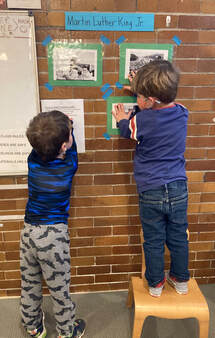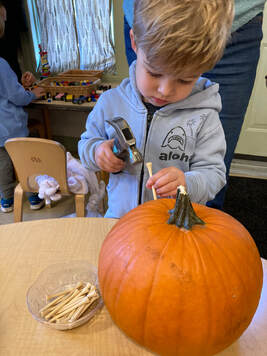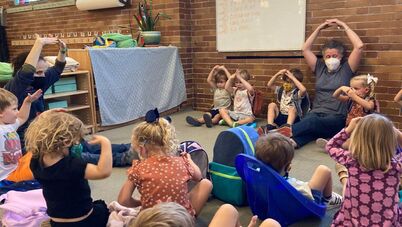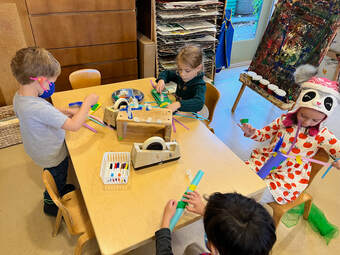|
At Lincoln Park Cooperative Nursery School, we are excited to begin our parent-teacher conferences next week. These conferences provide a valuable opportunity to strengthen our partnership with you as we work together to support your child's growth and development. Our goal is to engage in a meaningful conversation, where we share observations and explore questions that will guide us in setting goals for your child in the upcoming school year.
Preparation Before your scheduled conference, we encourage you to reflect on the following points:
What to Expect from Teachers During the conference, our dedicated teachers will share their insights, including:
Setting Goals As you prepare for the conference, consider potential goals related to your child's:
This list is not exhaustive and we invite you to provide your own insights. We are eager to hear your thoughts on other meaningful goals for your child's school experience. We look forward to engaging in these important conversations with you.
0 Comments
 This Monday, January 16th, we honor and celebrate the life of Dr. Martin Luther King, Jr. The holiday provides an opportunity to discuss diversity and justice with young children in simple ways. Below, I share staff insights into the day and suggestions for talking to your children about race, diversity, and MLK Jr. From Junior Kindergarten Barbara and Debbie began conversations about equity and fairness by reading the book Swimmy by Leo Leonni. Teachers aimed to focus on how small actions, together, make a just and inclusive community. The class talked about how speaking up and leading encourages others to take action and protect others together. Swimmy highlights the power of organizing in a way that is relatable and meaningful to young children. From Four Day During snack on Wednesday and Thursday in Four Day, we shared photos of Martin Luther King Jr. as a father and an organizer. We told children that he was a helper and he got people together to help make things fair. We then asked them if they knew what the word fair meant. One child answered, “It’s the World Fair.” Another quickly added, “Like a carnival.” They needed more information. We offered relatable examples of only curly haired people being allowed to eat snack or only people with gray pants being allowed to play at the table. Would that be fair? We heard a resounding “No!” We told them that we are celebrating MLK day on Monday because of what an important person he was. One child asked if he died and we said yes, a long time ago. We didn’t go into more details, just responded to what the children asked. Talking to Preschoolers about MLK Jr. and race Talking to young children about race is important, because early childhood is a crucial and vulnerable period for identity development. Between 2 ½ and 3 ½, children move beyond noticing differences and begin absorbing socially prevailing negative stereotypes, feelings, and ideas about people, including themselves. By the time they are 4, children are seeking labels for racial/ethnic identity and have their own theories about what causes a disability, skin tone, and gender. (Derman-Sparks, Teaching for Change).
 This next phase of the school year begins as children have successfully separated from their caregivers and transferred trust to their classroom teachers. All separation looks different, takes varying amounts of time and can certainly be an ebb and flow. But the hallmark is a child’s ability to say goodbye to their adult and cross the threshold into the classroom with little to no distress. Teachers use tools to help ease separation: notes to or from home, transition objects like lovies, or a separation plan which could include a special hug or kiss followed by a special story once inside the classroom. Teachers become a child’s go-to source of reference. They will seek out a teacher in moments of big feelings - joy or sadness - share in experiences like painting and building or ask for help with basic tasks like fastening buttons or dressing for outside. As this is occurring, teachers are setting up the environment to encourage children to become more autonomous. Children’s increasing comfort in the classroom lends itself to their ability to explore and engage in tasks independently. Classroom design is changing, too. Rather than the familiar and comforting activities that first lured them into the classroom, teachers are introducing new materials and children have a say in what is happening in various parts of the classroom. The dramatic play area is now transforming based on children’s interests. Hotels, animal hospitals, and restaurants draw on children’s love of pretend and acting out familiar scripts - building on themes like caregiving and familial roles. Opportunities for self-help skills are evident throughout the day. Children work to hang up their backpacks and coats as they arrive, dress themselves in their winter gear, and care for the classroom by participating in clean up as a group. Relationships between children, their teachers, and their peers are growing. Children reference one another in play, tune into each other’s feelings, and seek to make genuine connections. This phase of the school year will last the majority of the year, giving way to mastery - the phase in which children feel pride in “knowing how to be at school.” For now, let us relish in their growing comfort and competence, sharing together in the joy of preschool. The idea of a greater mixed age grouping is something we have thought a lot about in crafting new class offerings for the 2023-24 school year. We find great value in a mixed age classroom community. Here are some of the benefits we already see and know:
 At LPCNS, we approach the school year through the lens of a phase model. The model consists of three phases: separation, autonomy, and mastery. They coincide with the goals we have for children as they begin and move through the school year. Each phase builds upon the other and is rooted in the relationships between children, families, and their teachers. The first phase of any year is separation. Our approach to separation is rooted in Attachment Theory (Bowlby, 1969/1982; Ainsworth et al., 1978) which draws from the evolutionary theory that explores the biologically based desire for proximity with the primary caregiver. This proximity leads to the formation of an attachment relation between attachment figure (parent) and the child (DeVries & Zan, 2012). In other words, children seek comfort in being close to the adults in their lives. They come to rely on the consistency and stability their caregivers provide and those relationships inform the way they experience the world. At LPCNS, we recognize the importance of the bond between a child and their caregiver and the influence it has on a child entering school for the first time...or even by the 100th time. We support a gentle separation policy that allows caregivers to remain in the classroom for extended periods of time until teachers feel the child has comfortably separated from their caregiver. A longer separation does not equal a negative or unhealthy one. Teachers look for the following signs that children are ready to comfortably say good-bye:
Thank you for your trust and collaboration. Our classrooms are bustling with activity and the seeds of wonderful communities of learning have been planted. It was exciting to welcome assisting adults into the classroom this week. We hope your experiences in the classrooms provide insight into your child’s day and cultivate the opportunity for you to learn and grow together. |
ABOUTLincoln Park Cooperative Nursery School is a play-based, cooperative preschool in the heart of Lincoln Park. ARCHIVES |



